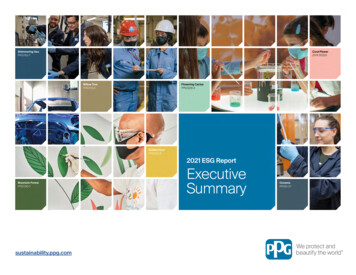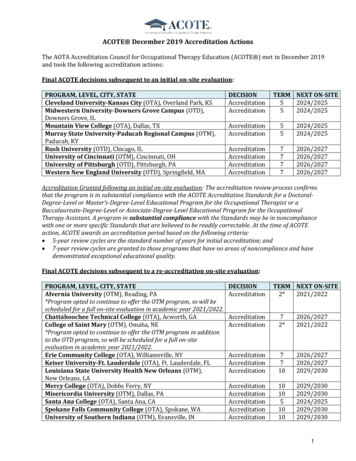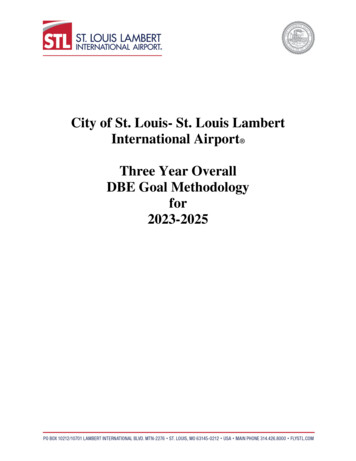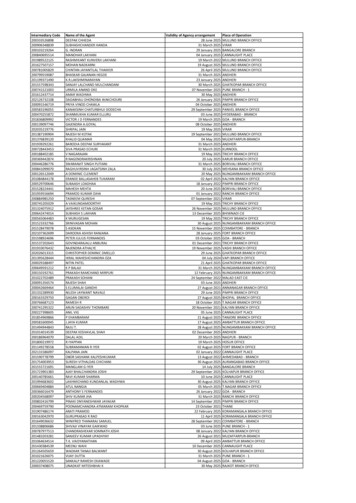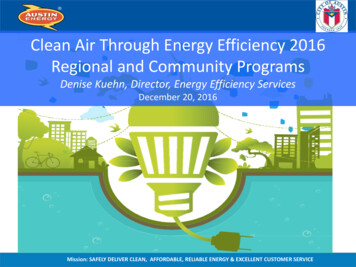
Transcription
STATE & FEDERAL UPDATE (AS OF JULY 1, 2015) 1Getting to 2025:A Senior LivingRoadmapEXECUTIVE MEMBER REPORTAPRIL 2016ARGENTUM ADVOCATES FOR YOUYEAR-END REPORTEXECUTIVE SUMMARY
ABOUT ARGENTUMArgentum member companies operate senior living communities offering assisted living,independent living, and memory care services to older adults and their families. Argentumis the largest national association exclusively dedicated to supporting companies operatingprofessionally managed, resident-centered senior living communities and the older adultsand families they serve. Since 1990, Argentum has advocated for choice, accessibility,independence, dignity, and quality of life for all older adults.Executive Summary3Introduction10Workforce Development15Quality Care21Operational Excellence24Consumer Choice26Memory Care29Conclusion31
GETTING TO 2025: A ROADMAP FOR THE SENIOR LIVING INDUSTRYEXECUTIVE SUMMARYUntil the 1980s, seniors who could not live safely in their own home or with family had few alternatives to institutional care.Today, more than 835,200 seniors live in senior living communities where they can get the assistance they need when theyneed it while maintaining their privacy, dignity, and respect with assistance of a professional caring staff.Since 1990, Argentum has advocated for choice, accessibility, independence, dignity, and quality of life for all older adults.Argentum member companies operate senior living communities offering assisted living, independent living, and memorycare services to older adults and their families. Argentum is the largest national association exclusively dedicated tosupporting companies operating professionally managed, resident-centered senior living communities and the older adultsand families they serve.THE SENIOR LIVING LANDSCAPEAmericans are living longer, and the enormous baby boomer population born between 1946 and 1964 began turning 65in 2011. According to the U.S. Census Bureau, when the last of the baby boomers reach age 65 in 2029 they will represent more than 20% of the total U.S. population, numbering about 60 million people. Because about 70% of the 65-pluspopulation - including many people with cognitive impairment - requires some form of long-term care, according to the U.S.Department of Health and Human Services, the aging U.S. population will create unprecedented demand for the services ofthe senior living industry in the coming decades.This roadmap analyzes the current landscape of senior living care, and forecasts the 10-year outlook of the industry. It wasproduced in consultation with hundreds of top senior living executives and other advocates, thought leaders, and policyexperts, outlining the most significant opportunities and challenges facing the senior living industry over the next decade.WORKFORCE DEVELOPMENTCONSUMER CHOICEGrowing a workforce of trained professionalsto serve seniors.Promoting strategies for financing long termcare services and supports.QUALITY CAREMEMORY CARENurturing environments that enhance thequality of life for senior living residents.OPERATIONAL EXCELLENCEImproving the senior living business throughinnovation and technology.Enhancing awareness and best practicesfor the care of residents with dementia.3
4 GETTING TO 2025: A ROADMAP FOR THE SENIOR LIVING INDUSTRYWORKFORCE DEVELOPMENT – AN INDUSTRY OF CHOICESenior living staff are unparalleled in their passion and commitment to providing a safe, thriving, and engaged environmentfor residents and families. More workers are choosing senior living as a career path but as the nation’s aging demographicswells, the industry will need more workers and often will be competing with the broader service sector to find thoseemployees. These macro level changes in population demographics will have a significant effect on industry’s ability togrow and meet future needs of older adults; the industry needs to be innovative in attracting workers. A strong workforce ofqualified employees is essential for the senior living industry.OPPORTUNITIES»» Ensure meaningful public policy and legislation and try toprevent passage of reform that would negatively impact providersand the residents they serve.»» Expand job creation and invest in training and developmentopportunities for the existing and future workforce.»» Research to understand drivers of employment and engagement.»» Partner with academic institutions to address the growing needfor senior living professionals and encourage them to expandand promote programs and certifications in senior housingmanagement, services, and caregiving.»» Develop and track baseline metrics associated with employeeengagement, perceptions, and satisfaction.»» Develop professional credentials to elevate the status of theprofession in the eyes of current and prospective workersand provide the industry with a standard for evaluating staffqualifications. Argentum has formed the nonprofit Senior LivingCertification Commission dedicated to professional developmentinitiatives for senior living executives and staff members.An Industry of CHOICEGrowing a workforce of trained professionals to serve America’s older adultsʼ25347,000Addingnew jobs by 2025,senior living employment will exceed 1.1 million.The industrywill needto recruitmillion newemployees by 2025.1.21. Argentum analysis of Bureau of Labor Statistics data, 2001 - 2014.The senior living industryoutpaced average U.S. jobgrowth by3.7%1.
GETTING TO 2025: A ROADMAP FOR THE SENIOR LIVING INDUSTRYQUALITY CARE – AN INDUSTRY OF SERVICEOlder adults who socialize, exercise, embrace wellness, and engage with their friends, families and loved ones are happierand healthier, according to the Centers for Disease Control. Senior living provides a place to engage in community life.Residents and families report high satisfaction levels with their senior living experience. But marked growth in resident acuitywill significantly impact the senior living industry over the next 10 years. Additionally, the senior living industry is seeingincreased state regulatory changes with variances in regulatory models across the country. The industry needs standardsand professional certification programs to show its commitment to quality to the public, professionals and among employers.OPPORTUNITIES»» Support licensing and enforcement to protect residents andtheir families from unlicensed providers that harm consumers byoffering substandard care, and harm the reputation of the entireindustry as well.»» Advocate for state regulatory reform to ensure meaningful andconsistent laws and policy.»» Participate in the healthcare continuum by working withnetworks of providers within and beyond the health care sectorso the industry can leverage its capabilities and support seniorliving residents across the continuum of care.»» Encourage innovation by supporting the development ofresearch and participating in longitudinal studies to assess andmeasure the effects of innovative practices in senior care.»» Develop standards to demonstrate senior living’s commitmentto excellence and develop a self-regulatory framework that isflexible and meaningful.»» Share quality indicators and best practices throughout theindustry and among other senior living advocates to ensurecontinuous improvement.An Industry of SERVICENurturing environments that enhance the quality of life for senior living residents75%of senior living residents currently arediagnosed with at least two chronic conditions.130%of statesmade changesto assisted livingregulations in 2012-2013.21 in 5Americans willbe eligible for Medicare in 2030,causing significantexpenditures forthe program.31. Centers for Disease Control 2. “Best Practices in Managing Acuity Creep in Assisted Living” presented to a 2015 American Health Lawyers Association meeting3. Centers for Medicare & Medicaid Services, Kaiser Family Foundation5
6 GETTING TO 2025: A ROADMAP FOR THE SENIOR LIVING INDUSTRYOPERATIONAL EXCELLENCE – AN INDUSTRY OF INNOVATIONFor industry executives to balance operating a thriving business and appealing to a more demanding consumer, they mustcreate more efficient operating environments through technology and innovation. As healthcare providers expand beyondaddressing an older adult’s illness in a doctor’s office and follow that patient to the most appropriate care setting, senior livingproviders must be poised to embrace new business relationships and offer their services in new ways. Senior living leadersmust advocate for state regulatory models allowing innovation. Residents also are arriving in senior living communities athigher acuity levels than in the past, spurring a need for leaders to adapt to offer the same high level of services.OPPORTUNITIES»» Develop benchmarks and share financial and operationalperformance metrics among industry leaders to analyze, create,and implement the next generation of senior living communities.»» Identify and enhance the use of technology to improveadministrative efficiencies. For example, the integration ofonline databases and tracking systems for logging residentinformation — such as schedules, medications, and visitors —better equips providers to manage their residents’ quality andconsistency of care.»» Innovate by cultivating leaders, embracing new ideas, andrecognizing disruptors to ensure senior living continues to offernew products and services ultimately benefiting residents andtheir families.»» Implement electronic heath records to aid in capturing clinicalcare needs, collect and share outcomes with residents, familiesand health care providers.»» Share best practices to raise the bar of excellence throughoutthe industry.An Industry of INNOVATIONImproving the senior living business through innovation and technology17.4%of residential care communities usedelectronic health records for purposes other thanbilling or accounting.120%of residentialcare communities useelectronic health records.21. October 2015 Health Affairs2. 2012 National Study of Long-Term Care ProvidersOf top performingcommunities inthe area of quality of management,of residents, families and staffwould recommend theircommunity.395%3. National Research Corporation
GETTING TO 2025: A ROADMAP FOR THE SENIOR LIVING INDUSTRY7CONSUMER CHOICE – AN INDUSTRY OF INDEPENDENCESenior living is a great and affordable opportunity for older adults to experience an optimal quality of life in a social setting. AsAmericans are living longer than ever before, they have more opportunity to engage in their community, share experiences,and enjoy family and friends. But as average life expectancy reached a high of 78.8 years in 2012, that also puts a strain onretirement savings. Americans are saving less, living longer, and unfortunately unprepared for the cost of long-term care.Aging baby boomers will lift the number of older households aged 65 and over 42% by 2025, and double the number aged80 and over by 2035.OPPORTUNITIES»» Support public education to increase the amount of readilyavailable public information about the importance of saving forlong-term care.»» Support public policy options to provide widespreadaffordable senior housing through the development of taxcredits and reimbursements.»» Promote tax incentives and financing options to encourageand help people to begin saving early in life for long-term care.»» Create innovative financing models that are attractive tomiddle income older adults.»» Champion long-term care insurance and the benefits it canprovide to help individuals and families save for the costsof long-term care.»» Work to eliminate elder abuse through public education andsupport of policies and programs that seek to mitigate andeliminate financial exploitation of seniors.»» Encourage state-based savings initiatives to expand retirementsavings options among private sector employees.»» Develop and track baseline metrics associated with consumer,resident, and family perceptions and satisfaction levels.An Industry of INDEPENDENCEPromoting strategies for financing long term care services and supportsBetween 2015 and 2055, the number of older Americans withsevere long term services and support needs will increase140%, reaching 15.1 million.18%Less thanof Americans havepurchased long termcare insurance throughthe private market.21. 2015 Urban Institute studyA 65-year-old today will incur 138,100in future lifetime expenses forsevere long-term needs. 15% of those65 year olds will incur more than 250,000.32. Robert Wood Johnson Foundation, Congressional Budget Office3. 2015 Urban Institute study
8 GETTING TO 2025: A ROADMAP FOR THE SENIOR LIVING INDUSTRYMEMORY CARE – AN INDUSTRY OF DIGNITY AND RESPECTWhile a critical issue for everyone, it is senior living providers that will offer care, community, and support to this growingpopulation and they must take action to help society unravel the mystery of Alzheimer’s disease and other dementias. Aspeople live longer at higher levels of acuity, it has become increasingly more important that senior living be the primarycaregiver for people with dementias. The senior living industry must step up to advance technology, services, and researchto promote a treatment, cure, and greater quality of life for those affected by dementia. It is up to senior living providers andtheir partners to build environments that support compassionate, purposeful living.OPPORTUNITIES»» Boost public understanding of Alzheimer’s and other dementiasto enhance public awareness, reduce stigma, and supportefforts to fund research.»» Promote disease management to help prevent and slow theprogression of Alzheimer’s in residents.»» Encourage participation in scientific studies by encouragingresidents and their families to participate in relevant clinical trials.»» Support and expand dementia friendly communities byworking to offer resources and assistance to foster the spread ofcommunities that recognize a person with cognitive impairment,to respect them and create environments that are friendly to them.»» Develop and share best practices to continue to advancesenior living’s knowledge base and expertise in the field.An Industry of DIGNITY AND RESPECTEnhancing quality of life for senior living residents with Alzheimer’s diseaseand related dementias from care to cure40%More thanof assisted living residents haveAlzheimer’s disease or other dementias.16thBy 2050, Alzheimer’sand other dementias isprojected to cost the nation 2261. Centers for Disease ControlAlzheimer’s is theleading cause of death inthe U.S. and the 5th leadingcause among adults aged65 to 85 years.3billion.22. Alzheimer’s Association3. Centers for Disease Control6#
GETTING TO 2025: A ROADMAP FOR THE SENIOR LIVING INDUSTRYCONCLUSIONThe next 10 years for the senior living industry is full of promise and opportunity. Senior living is working.Senior living leaders have an opportunity to accommodate the nation’s demand for eldercare while providing the high qualityof life that has made senior living an attractive long-term care option for older adults and their families. But as the nation’sdemographics shift and the healthcare arena is constantly morphing, the industry must embrace change and forge newalliances while continuing to build on its solid foundation.The swelling ranks of the nation’s older adults are changing the face of the nation, creating a complex array of opportunitiesand challenges for issues including healthcare, lifestyle choices, healthy aging, and long-term care financing. Argentum ishonored to be part of the solution supporting its members, offering older adults a choice in where they call home and somuch more.Argentum is the largest national association exclusively dedicated to supporting companies operating professionallymanaged, resident-centered senior living communities and the older adults and families they serve. Since 1990, Argentumhas advocated for choice, accessibility, independence, dignity, and quality of life for all seniors.Our member companies operate senior living communities offering assisted living, independent living, and memory careservices to seniors and their families. Senior living and memory care communities are licensed and regulated by all 50 statesand provide 24-hour supervision, meals, activities, medication management, and assistance as needed with activities of dailyliving such as dressing and bathing. Many seniors who were once isolated in their own homes, without friends or sense ofpurpose, thrive after moving into a senior living community — where they are surrounded with the nurturing care that all olderadults deserve. Senior living is home.Through an extensive six-month listening tour meeting with experts and advocates for older adults in a wide range ofprofessions, Argentum has crafted a look at key issues facing the industry over the next 10 years: Workforce Development,Quality Care, Operational Excellence, Consumer Choice, and Memory Care.By collaborating with stakeholders in senior living, healthcare, academia, business, government, and elsewhere, Argentumplans to focus on these five critical imperatives to craft new initiatives, partnerships, and goals to ensure the nation’s agingpopulation can experience choice, quality service, innovation, independence, dignity, and respect.9
10 GETTING TO 2025: A ROADMAP FOR THE SENIOR LIVING INDUSTRYINTRODUCTIONUntil the 1980s, seniors who could not live safely in their own home or with family had few alternatives to institutional care.Today, more than 835,200 seniors live in senior living communities where they can get the assistance they need whenthey need it while maintaining their privacy, dignity, and respect with assistance of a professional caring staff. This roadmapanalyzes the current landscape of senior living care, and forecasts the 10-year outlook of the industry.ProjectedNumberofResidentsDaily Residentsat ResidentialCare CommunitiesProjectedNumberof Dailyat ResidentialCare Communities2012 to 20252012 to sbasedfromtheofNationalof Long-TermSource: ALFAprojectionsbased on datafromonthedataNationalStudyLong-TermStudyCare Providers(NSLTCP)Care Providers (NSLTCP)conducted bybythetheU.S.U.S.Centersfor DiseaseControl andPrevention’sNational CenterNationalfor Health CenterStatistics for Health StatisticsconductedCentersfor DiseaseControland Prevention’sNote: Figures represent residents on any given day, rather than all residents in a year.Note: Figures represent residents on any given day, rather than all residents in a year.Americans are living longer, and the enormous baby boomer population born between 1946 and 1964 began turning65 in 2011. According to the U.S. Census Bureau, when the last of the baby boomers reach age 65 in 2029 they willrepresent more than 20% of the total U.S. population, numbering about 60 million people. Because about 70% of the65-plus population - including many people with cognitive impairment – requires some form of long-term care, accordingto the U.S. Department of Health and Human Services, the aging U.S. population will create unprecedented demand for theservices of the senior living industry in the coming decades.
GETTING TO 2025: A ROADMAP FOR THE SENIOR LIVING INDUSTRYDistribution of the Projected Older Population by Agefor the United States: 2010 to 2050Distribution of the Projected Older Population by Age for the United States: 2010 to 205010085 years and over9080 to 84 years807075 to 79 years60504070 to 74 years302065 to 69 :on thatAging,2008Note:LineAdministrationindicates the yeareachU.S.ageCensusgroup isBureau,the largestproportion of the older population.Source: U.S. Census Bureau, 2008.The likelihood of needing assistance increases with age, with 11% of adults aged 65 to 69 having a functional limitation,compared to 62% of the population 90 and older, according to a 2015 White House Conference on Aging policy brief.The growing demand for direct care workers is expected, “which raises issues of recruiting and retaining the direct careworkforce,” reads the brief.Approximately 20% (7.7 million) of older Americans receive assistance with their care needs, according to DisabilityStatistics.org. Women are more likely than men to need long-term services and supports, largely because they live longer. The averageresident of an assisted living community is 85 years or older, female and widowed, according to the National Center forHealth Statistics. The U.S. population of those 65 and over accounts for one-third of personal health care spending but makeup 13% of the population. In contrast, children make up 25% of the population and account for 13% of healthcare spending,according to the California Healthcare Foundation.Senior living leaders have an opportunity to accommodate this demand for elder care while providing the high quality of lifethat has made senior living an attractive long-term care option for older adults and their families.11
12 GETTING TO 2025: A ROADMAP FOR THE SENIOR LIVING INDUSTRYThe Senior Living Model Is WorkingOverall satisfaction90% ResidentsRecommendation to others91% Families90% Residents91% FamiliesSource: 2015 National Research Corp. research for ArgentumThe senior living model is working. 90% of residents report overall satisfaction with senior living while 91% of families do. 90%of residents would recommend assisted living to others while 91% of families would.Growth in the senior living industry tracks closely with the older adult population in the United States in recent years. Between2001 and 2014, the number of senior living communities increased 39%. During the same period, the U.S. population aged85 and older rose 43%. As a result of the similar growth rates, the number of senior living communities as a proportion of thesenior population has been relatively steady.Growthin SeniorEstablishmentsandPopulationGrowthin SeniorLivingLivingIndustryIndustry Establishmentsand85 85 PopulationFigures are indexed to 2001 100 for comparability purposes1601401201008060402002001 2002 2003 2004 2005 2006 2007 2008 2009 2010 201 1 2012 2013 2014Senior Living Industry Establishments85 PopulationSource: Argentum analysis of data from the Bureau of Labor Statistics and U.S. Census BureauSource: Argentum analysis from the U.S. Bureau of Labor Statistics and U.S. Census Bureau
GETTING TO 2025: A ROADMAP FOR THE SENIOR LIVING INDUSTRYProjected Growth in Senior Living Industry Establishments,Revenues and the 85 PopulationProjected Growth in Senior Living Industry Establishments and the 85 Population 2014 to 20252014 to 20257.5 million29,70024.468Senior Living IndustryEstablishments20146.2 million85 Population2025Source: Argentum projections of senior living industry establishments and ving industryestablishmentsand revenues; U.S. Census Bureau projectionsU.S.CensusBureau projectionspopulationaged 85 andolderof the population aged 85 and olderThe U.S. Census Bureau projects there will be 7.5 million residents aged 85 years or older living in the United States by 2025,up 21% from 6.2 million in 2014. If the current ratio of one senior living industry establishment per 252 residents aged 85 orolder holds, there will be approximately 29,700 senior living communities in the United States by 2025. This represents a21% increase over the 24,468 communities in 2014. The number of centenarians is increasing too.The Number of Centenarians Is Growing RapidlyBy 2050, the number of centenarians is expectedThe 2010 U.S. Census counted more than 53,000 people ageto increase 18 times. Although the proportion100 and older in the United States (two per 10,000) people, andof people who live beyond the age of 100 is still verythey were overwhelmingly female. For every 100 centenariansmall, their number is growing rapidly. In 2000, therewomen, there were only 20.7 centenarian men.were an estimated 180,000 centenarians throughout2050 they are projected to number3.2 million.100the world. BySource: United Nations and 2010 U.S. Census20.713
14 GETTING TO 2025: A ROADMAP FOR THE SENIOR LIVING INDUSTRYAnnualGrowthin the Numberof EstablishmentsAnnualGrowthin the Numberof Establishments2006 to 2013Continuing Care Retirement Communities and Assisted Living Communities vs. All U.S. 20.90.90.50%-0.1-0.9-1%-2%20062007Senior Living Industry200820092010201 120122013All U.S. IndustriesSource: Bureau of Labor StatisticsSource: Bureau of Labor StatisticsIn recent years, growth in the senior living industry outpaced the overall economy. Between 2001 and 2013, the number ofsenior living establishments in the United States increased 36%. During the same period, the number of establishments inall U.S. industries rose just 15%, demonstrating the need and demand for eldercare services and housing.This report, produced in consultation with hundreds of top senior living executives and other advocates, thought leaders,and policy experts, outlines the most significant opportunities and challenges facing the senior living industry over the next10 years in five key areas.OUR FIVE CRITICAL IMPERATIVESWORKFORCE DEVELOPMENTCONSUMER CHOICEGrowing a workforce of trained professionalsto serve seniors.Promoting strategies for financing long termcare services and supports.QUALITY CAREMEMORY CARENurturing environments that enhance thequality of life for senior living residents.OPERATIONAL EXCELLENCEImproving the senior living business throughinnovation and technology.Enhancing awareness and best practicesfor the care of residents with dementia.
GETTING TO 2025: WORKFORCE DEVELOPMENTWORKFORCE DEVELOPMENT – AN INDUSTRY OF CHOICEGROWING A WORKFORCE OF TRAINED PROFESSIONALS TO SERVE AMERICA’S OLDER ADULTSSenior living staff are unparalleled in their passion and commitment to providing a safe, thriving, and engaged environment forresidents and families. More workers are choosing senior living as a career path but as the nation’s aging demographic swells,the industry will need more workers and often will be competing with the broader service sector to find those employees.A strong workforce of qualified employees is essential for the senior living industry. Macro level changes in populationdemographics will have a significant effect on industry’s ability to grow and meet future needs of older adults; the industryneeds to be innovative in attracting workers. In a 2015 National Research Corporation consumer survey of more than 25,000households, only 8.5% of respondents ages 18 to 34 had a very high trust and confidence in assisted living, although about23% of that age group had fairly high trust and confidence and nearly 46% had some trust and confidence in it. This lack oftrust could be attributed more to a lack of awareness.At the same time we are facing a potential lack of trust or awareness from a younger workforce, the ratio of caregivers ages45 to 64 years old to those older than 80 is shrinking while the 85-plus population is projected to increase from 5.98 millionin 2012 to 14.1 million in 2040.Even with these demographic challenges, senior living continues to thrive. Industry job growth exceeded the overall economy in each of the last 13 years. Total senior living employment jumped 68% between 2001 and 2014, an increase of morethan 346,000 jobs. In contrast, total U.S. employment rose just 5% during this 13-year period, according to Argentum’s analysis of U.S. Bureau of Labor Statistics data.The RATIO OF CAREGIVERS(45-65 years old) to those over 80 will shrink.201420307:14 :1The SENIOR LIVING INDUSTRY is anengine of growth for the overall economy.Senior Living employmentINCREASED at an annual rate of4.1% between 2001 and 2014,while TOTAL U.S. JOB GROWTHaveraged just2050Source: AARP Public Policy Institute3 :10.4% a yearduring this period.Source: Argentum analysis of Bureau of Labor Statistics data.15
16GETTING TO 2025: WORKFORCE DEVELOPMENTSenior living industry job growth exceeded the overall economy in each of the last 13 years. Senior living employmentincreased at an average annual rate of 4.1% between 2001 and 2014, while total U.S. job growth averaged just 0.4% a yearduring this period.The senior living industry also continued to post steady employment growth during the Great Recession, even as most otherindustries were shedding jobs. Between 2007 and 2010, the senior living industry added more than 84,000 jobs, an increaseof nearly 13%, according to BLS data.Employment GrowthCCRCsinandCommunitiesvs. All U.S. IndustriesAnnualatGrowththeALNumberof EmployeesContinuing Care Retirement Communities and Assisted Living Communities vs. All U.S. .63.21.71.7-0.7-2%-4%-4.3-6%20062007Senior Living Industry200820092010201 120122013Total U.S. EmploymentSource: Bureau of Labor StatisticsSource: Argentum analysis of U.S. Bureau of Labor StatisticsA 2008 Institute of Medicine report projected that the United States will need an additional 3.5 million long-term carehealth workers by 2030 just to maintain the current ratio of workers per older resident. Additionally, 2013 Bureau of LaborStatistics show that employment in the nursing and residential care industries will increase nearly 24% from 2012 to 2022 andemployment in the home health care industry will rise nearly 60%. BLS 2014 data also project a 60% increase in employmentin the home health care services sector, 30% increase in residential care communities, and a 20% increase in nursing carefacilities over the next decade, according to a University of California San Francisco research report.
GETTING TO 2025: WORKFORCE DEVELOPMENTSenior Living 2025 Workforce 00600,000347,000Jobs Added43.9%Increase400,000200,000020122025Source: Argentum analysis of U.S. Bureau of Labor StatisticsUsing BLS data, Argentum
and help people to begin saving early in life for long-term care. » Champion long-term care insurance and the benefits it can provide to help individuals and families save for the costs of long-term care. » Encourage state-based savings initiatives to expand retirement savings options among private sector employees.




